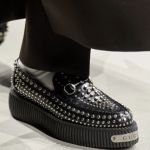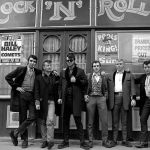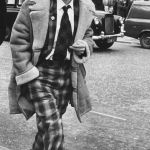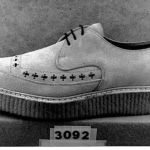
The history and comeback of the creeper
From subculture symbol to fashion
March 9th, 2024
The iconic platform shoes have passed into the common imagination as a symbol of the punk subculture, but they are also a source of inspiration for brands such as Prada and Vivienne Westwood and have been animating the haute couture catwalks for decades in their most extravagant declinations. Their latest appearance? Gucci's FW24, the first menswear collection by artistic director Sabato de Sarno, who brought the shoe's signature silhouette back to the catwalk. While we previously knew Gucci for its loafers, the new collection reinterprets it through the look of the classic Creeper, adding the thick, knurled sole to a sleek shoe. It's not the first time these shoes have made their debut for a luxury brand, with the latest example coming from Marni's Pre-Fall 2021, but their origins belong to the British streets. Let's discover the history of the creepers together.
The post-war period and the Brothel Creeper
1945. The war is over and the British soldiers who fought in the deserts of North Africa also return home. Trying to forget the horror and leave the battlefields behind, once in London they spend their days and nights wandering the streets, night clubs and brothels of Soho and King's Cross with a strange pair of shoes on their feet. They do not go unnoticed, and because of the area in which they are 'spotted', some people are starting to nickname them Brothel Creeper. These are hard-wearing suede boots, equipped with a thick rigid sole with anti-ice crampons, made from layered sheets of coagulated latex, which, initially supplied by the army to cope with the harsh desert climate, became for many veterans a kind of unintentionally cool uniform.The post-war period and the Brothel Creeper
The restyling and the Teddy Boy subculture
The first to realise the commercial potential of these shoes was in 1949 the George Cox Footwear, an American company based in Wellingborough in Northamptonshire, which launched its own version with a more fashionable silhouette, The Hamilton: 4 to 6 cm high para sole, four-ring lacing and shiny leather or suede upper. Cox's restyling was a success and, helped by the contemporary emergence of the first youth countercultures, the new product became an integral part of the look along with the banana topknot, dark blazers, high-necked sweet waists, slim trousers, short and with the hems folded so as to leave the ankle free, of the Teddy Boys, who with their mix of sartorial codes dating back to the period, dandyism and rockabilly rebellion, invaded neighbourhoods in Europe and the States. At a certain point, the Creepers (according to some, the name comes from a song and dance in vogue among Teds in the early 1950s: 'The Creep', by Ken Mackintosh) became so popular that Elvis dedicated one of his most famous pieces 'Blue suede shoes' to them.
The punk counterculture
In the 1970s, rejecting the hippie look that was all the rage, Malcolm McLaren brought the Teddy Boy style back into vogue by buying a pair of suede D-ring creeper shoes from Mr Freedom. He was so enthusiastic about it that, by the time he had become manager of a band destined to make music history, the Sex Pistols, he decided to order more models from the factory to sell them in the Let It Rock, then SEX and finally Seditionaries boutique, opened at 430 King's Road together with his partner and life companion, Vivienne Westwood. Many years later, recalling the importance of his creeper in establishing the punk style of the Sex Pistols and Westwood, McLaren would declare:
«My pair of George Cox's was probably the most important thing I ever bought. They were a style statement, breaking away from everything else people wore and thought. Putting on a pair of those shoes was a symbolic act.»
The creepers now
After a relative oblivion in the 1990s, the creeper has been back in fashion since 2000, exhumed and reworked by many designers and celebrities: Alexander Wang, Chanel, Rihanna for Fenty PUMA, Prada, who made a mash-up version of them with espadrilles, Yamamoto, Comme des Garçons Homme who took them down the catwalk during PFW FW19, adidas Originals and Kazuki Kuraishi, through to Nicholas Daley & George Cox's Monk Strap Creeper. The return of the knurled sole to the catwalk at this winter's Milan Men's Fashion Week confirms that the creeper is an iconic phenomenon that, despite the constant change of fashions, continues to appeal to the coolest of people.


























































































